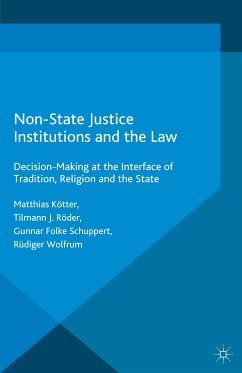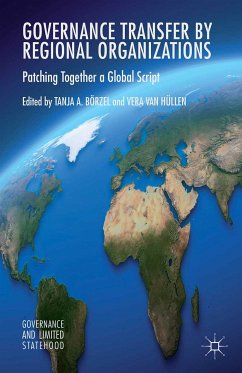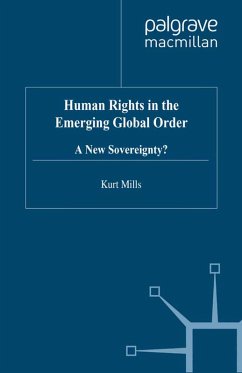Non-State Justice Institutions and the Law (eBook, PDF)
Decision-Making at the Interface of Tradition, Religion and the State
Redaktion: Kötter, M.; Wolfrum, R.; Schuppert, F.; Röder, T.
40,95 €
40,95 €
inkl. MwSt.
Sofort per Download lieferbar

20 °P sammeln
40,95 €
Als Download kaufen

40,95 €
inkl. MwSt.
Sofort per Download lieferbar

20 °P sammeln
Jetzt verschenken
Alle Infos zum eBook verschenken
40,95 €
inkl. MwSt.
Sofort per Download lieferbar
Alle Infos zum eBook verschenken

20 °P sammeln
Non-State Justice Institutions and the Law (eBook, PDF)
Decision-Making at the Interface of Tradition, Religion and the State
Redaktion: Kötter, M.; Wolfrum, R.; Schuppert, F.; Röder, T.
- Format: PDF
- Merkliste
- Auf die Merkliste
- Bewerten Bewerten
- Teilen
- Produkt teilen
- Produkterinnerung
- Produkterinnerung

Bitte loggen Sie sich zunächst in Ihr Kundenkonto ein oder registrieren Sie sich bei
bücher.de, um das eBook-Abo tolino select nutzen zu können.
Hier können Sie sich einloggen
Hier können Sie sich einloggen
Sie sind bereits eingeloggt. Klicken Sie auf 2. tolino select Abo, um fortzufahren.

Bitte loggen Sie sich zunächst in Ihr Kundenkonto ein oder registrieren Sie sich bei bücher.de, um das eBook-Abo tolino select nutzen zu können.
This book focuses on decision-making by non-state justice institutions at the interface of traditional, religious, and state laws. The authors discuss the implications of non-state justice for the rule of law, presenting case studies on traditional councils and courts in Pakistan, South Sudan, Ethiopia, Bolivia and South Africa.
- Geräte: PC
- ohne Kopierschutz
- eBook Hilfe
- Größe: 1.14MB
Andere Kunden interessierten sich auch für
![The United States Constitution (eBook, PDF) The United States Constitution (eBook, PDF)]() J. VileThe United States Constitution (eBook, PDF)112,95 €
J. VileThe United States Constitution (eBook, PDF)112,95 €![Governance Transfer by Regional Organizations (eBook, PDF) Governance Transfer by Regional Organizations (eBook, PDF)]() Tanja A. BörzelGovernance Transfer by Regional Organizations (eBook, PDF)40,95 €
Tanja A. BörzelGovernance Transfer by Regional Organizations (eBook, PDF)40,95 €![Memory and Transitional Justice in Argentina and Uruguay (eBook, PDF) Memory and Transitional Justice in Argentina and Uruguay (eBook, PDF)]() Francesca LessaMemory and Transitional Justice in Argentina and Uruguay (eBook, PDF)40,95 €
Francesca LessaMemory and Transitional Justice in Argentina and Uruguay (eBook, PDF)40,95 €![Human Rights in the Emerging Global Order (eBook, PDF) Human Rights in the Emerging Global Order (eBook, PDF)]() K. MillsHuman Rights in the Emerging Global Order (eBook, PDF)112,95 €
K. MillsHuman Rights in the Emerging Global Order (eBook, PDF)112,95 €![The Role of Human Rights in Foreign Policy (eBook, PDF) The Role of Human Rights in Foreign Policy (eBook, PDF)]() P. BaehrThe Role of Human Rights in Foreign Policy (eBook, PDF)40,95 €
P. BaehrThe Role of Human Rights in Foreign Policy (eBook, PDF)40,95 €![Freedom of Expression in a Diverse World (eBook, PDF) Freedom of Expression in a Diverse World (eBook, PDF)]() Freedom of Expression in a Diverse World (eBook, PDF)72,95 €
Freedom of Expression in a Diverse World (eBook, PDF)72,95 €![Global Politics of Health Reform in Africa (eBook, PDF) Global Politics of Health Reform in Africa (eBook, PDF)]() Amy BarnesGlobal Politics of Health Reform in Africa (eBook, PDF)40,95 €
Amy BarnesGlobal Politics of Health Reform in Africa (eBook, PDF)40,95 €-
-
-
This book focuses on decision-making by non-state justice institutions at the interface of traditional, religious, and state laws. The authors discuss the implications of non-state justice for the rule of law, presenting case studies on traditional councils and courts in Pakistan, South Sudan, Ethiopia, Bolivia and South Africa.
Dieser Download kann aus rechtlichen Gründen nur mit Rechnungsadresse in A, B, BG, CY, CZ, D, DK, EW, E, FIN, F, GR, HR, H, IRL, I, LT, L, LR, M, NL, PL, P, R, S, SLO, SK ausgeliefert werden.
Produktdetails
- Produktdetails
- Verlag: Palgrave Macmillan UK
- Seitenzahl: 252
- Erscheinungstermin: 2. Februar 2015
- Englisch
- ISBN-13: 9781137403285
- Artikelnr.: 45972467
- Verlag: Palgrave Macmillan UK
- Seitenzahl: 252
- Erscheinungstermin: 2. Februar 2015
- Englisch
- ISBN-13: 9781137403285
- Artikelnr.: 45972467
- Herstellerkennzeichnung Die Herstellerinformationen sind derzeit nicht verfügbar.
Katharina Diehl, Max Planck Foundation for International Peace and the Rule of Law, Germany. Girmachew Alemu Aneme, University of Addis Ababa, Ethiopia. Justice Ruben Madol Arol, Supreme Court of South Sudan, Juba, South Sudan Simone Malz, Max Planck Institute for Comparative Public Law and International Law, Germany. Lorena Ossio Bustillos, Max Planck Institute for Social Law and Social Policy, Germany. Christa Rautenbach, North-West University, South Africa. Naveed Ahmad Shinwari, Community Appraisal and Motivation Programme (CAMP), Pakistan. Brian Z. Tamanaha, Washington University, Illinois, USA.
Introduction: A Bifurcated Theory of Law in Hybrid Societies: The Rule of Law and Non-state Justice; Brian Z. Tamanaha 1.1. The Recent Turn to Non-state Justice Institutions 1.2. How Hybrid Legal Situations Came About 1.3. A Bifurcated Law and Society 1.4. The Apparent Misfit with the Rule of Law 1.5. Conclusion PART I: RECOGNIZING NON-STATE JUSTICE INSTITUTIONS: FIVE CASES 1. Pakistan: Jirgas Dispensing Justice without State Control; Tilmann J. Röder and Naveed A. ShinwarI 1.1. Introduction 1.2. Governance and Dispute Settlement in FATA 1.3. Legality and Legitimacy of Decision-Making in the Existing Framework 1.4. Conclusions 2. South Sudan: Linking the Chiefs' Judicial Authority and the Statutory Court System; Katharina Diehl, Ruben Madol Arol and Simone Malz 2.1. Introduction: Traditional Authorities and Customary Law in South Sudan 2.2. Contemporary Legal Framework of the Judicial System 2.3. Decision-Making in the Customary Court System 2.4. Interaction of Statutory Courts and Customary Courts - Two Parallel Systems or Two Branches of the Same Legal Structure? 2.5. Conclusion: The Political Relevance of Chief Courts in the Post-Conflict Situa-tion of South Sudan 3. Ethiopia: Legal and Judicial Plurality and the Incorporation of Traditional Dispute Resolution Mechanisms within the State Justice System (Girmachew Alemu Aneme) 3.1. Introduction 3.2. The State Justice System 3.3. The Incorporation of the Traditional Dispute Resolution Process of Shimglina within the State Justice System 3.4. The Non-State Justice Systems 3.5. Conclusions 4. Bolivia: Normative Equality between State and Customary Law. Utopia or the Future of Hybrid Normative Systems?; Lorena Ossio Bustillos 4.1. General Introduction to the Country and the Justice System 4.2. Authority System in Traditional Justice (Customary Law) 4.3. Constitutionalization and Legislation of Indigenous Law 4.4. The Mandatory Nature of the Indigenous Legal System 4.5. Conclusion 5. South Africa: Legal Recognitionof Traditional Courts ? Legal Pluralism in Action; Christa Rautenbach 5.1. Introduction 5.2. Historical Context 5.3. Contemporary Legal Framework 5.4. Concluding Remarks PART II: NON-STATE JUSTICE INSTITUTIONS AND THE LAW: CONCEPTUAL APPROACHES 1. Non-state Justice Institutions: A Matter of Fact and a Matter of Legislation (Matthias Kötter) 1.1. Non-State Justice Institutions and the Rule of Law 1.2. Various Degrees of Statehood and Non-State Justice Institutions 1.3. Incorporating Non-State Justice Institutions into the State Law System 1.4. Design of Regulations 1.5. Conclusion 2. From Normative Pluralism to a Pluralism of Norm Enforcement Regimes:A Governance Research Perspective; Gunnar Folke Schuppert 2.1. From 'Legal Pluralism' to 'Judicial Pluralism' 2.2. On the Enforcement Dimension of Every Normative Order 2.3. A Survey of the Diverse Regimes of Norm Enforcement: From Government Mandated Law Enforcement to Compliance Management within a Firm 2.4. A Few Critical Concluding Remarks 3. Legal Pluralism from the Perspective of International Law; Rüdiger Wolfrum 3.1. Introduction 3.2. Legal Pluralism and International Law in General 3.3. Objectives Pursued through Legal Pluralism in Selected National Legal Systems 3.4. Conclusion
Introduction: A Bifurcated Theory of Law in Hybrid Societies: The Rule of Law and Non-state Justice; Brian Z. Tamanaha 1.1. The Recent Turn to Non-state Justice Institutions 1.2. How Hybrid Legal Situations Came About 1.3. A Bifurcated Law and Society 1.4. The Apparent Misfit with the Rule of Law 1.5. Conclusion PART I: RECOGNIZING NON-STATE JUSTICE INSTITUTIONS: FIVE CASES 1. Pakistan: Jirgas Dispensing Justice without State Control; Tilmann J. Röder and Naveed A. ShinwarI 1.1. Introduction 1.2. Governance and Dispute Settlement in FATA 1.3. Legality and Legitimacy of Decision-Making in the Existing Framework 1.4. Conclusions 2. South Sudan: Linking the Chiefs' Judicial Authority and the Statutory Court System; Katharina Diehl, Ruben Madol Arol and Simone Malz 2.1. Introduction: Traditional Authorities and Customary Law in South Sudan 2.2. Contemporary Legal Framework of the Judicial System 2.3. Decision-Making in the Customary Court System 2.4. Interaction of Statutory Courts and Customary Courts - Two Parallel Systems or Two Branches of the Same Legal Structure? 2.5. Conclusion: The Political Relevance of Chief Courts in the Post-Conflict Situa-tion of South Sudan 3. Ethiopia: Legal and Judicial Plurality and the Incorporation of Traditional Dispute Resolution Mechanisms within the State Justice System (Girmachew Alemu Aneme) 3.1. Introduction 3.2. The State Justice System 3.3. The Incorporation of the Traditional Dispute Resolution Process of Shimglina within the State Justice System 3.4. The Non-State Justice Systems 3.5. Conclusions 4. Bolivia: Normative Equality between State and Customary Law. Utopia or the Future of Hybrid Normative Systems?; Lorena Ossio Bustillos 4.1. General Introduction to the Country and the Justice System 4.2. Authority System in Traditional Justice (Customary Law) 4.3. Constitutionalization and Legislation of Indigenous Law 4.4. The Mandatory Nature of the Indigenous Legal System 4.5. Conclusion 5. South Africa: Legal Recognitionof Traditional Courts ? Legal Pluralism in Action; Christa Rautenbach 5.1. Introduction 5.2. Historical Context 5.3. Contemporary Legal Framework 5.4. Concluding Remarks PART II: NON-STATE JUSTICE INSTITUTIONS AND THE LAW: CONCEPTUAL APPROACHES 1. Non-state Justice Institutions: A Matter of Fact and a Matter of Legislation (Matthias Kötter) 1.1. Non-State Justice Institutions and the Rule of Law 1.2. Various Degrees of Statehood and Non-State Justice Institutions 1.3. Incorporating Non-State Justice Institutions into the State Law System 1.4. Design of Regulations 1.5. Conclusion 2. From Normative Pluralism to a Pluralism of Norm Enforcement Regimes:A Governance Research Perspective; Gunnar Folke Schuppert 2.1. From 'Legal Pluralism' to 'Judicial Pluralism' 2.2. On the Enforcement Dimension of Every Normative Order 2.3. A Survey of the Diverse Regimes of Norm Enforcement: From Government Mandated Law Enforcement to Compliance Management within a Firm 2.4. A Few Critical Concluding Remarks 3. Legal Pluralism from the Perspective of International Law; Rüdiger Wolfrum 3.1. Introduction 3.2. Legal Pluralism and International Law in General 3.3. Objectives Pursued through Legal Pluralism in Selected National Legal Systems 3.4. Conclusion







